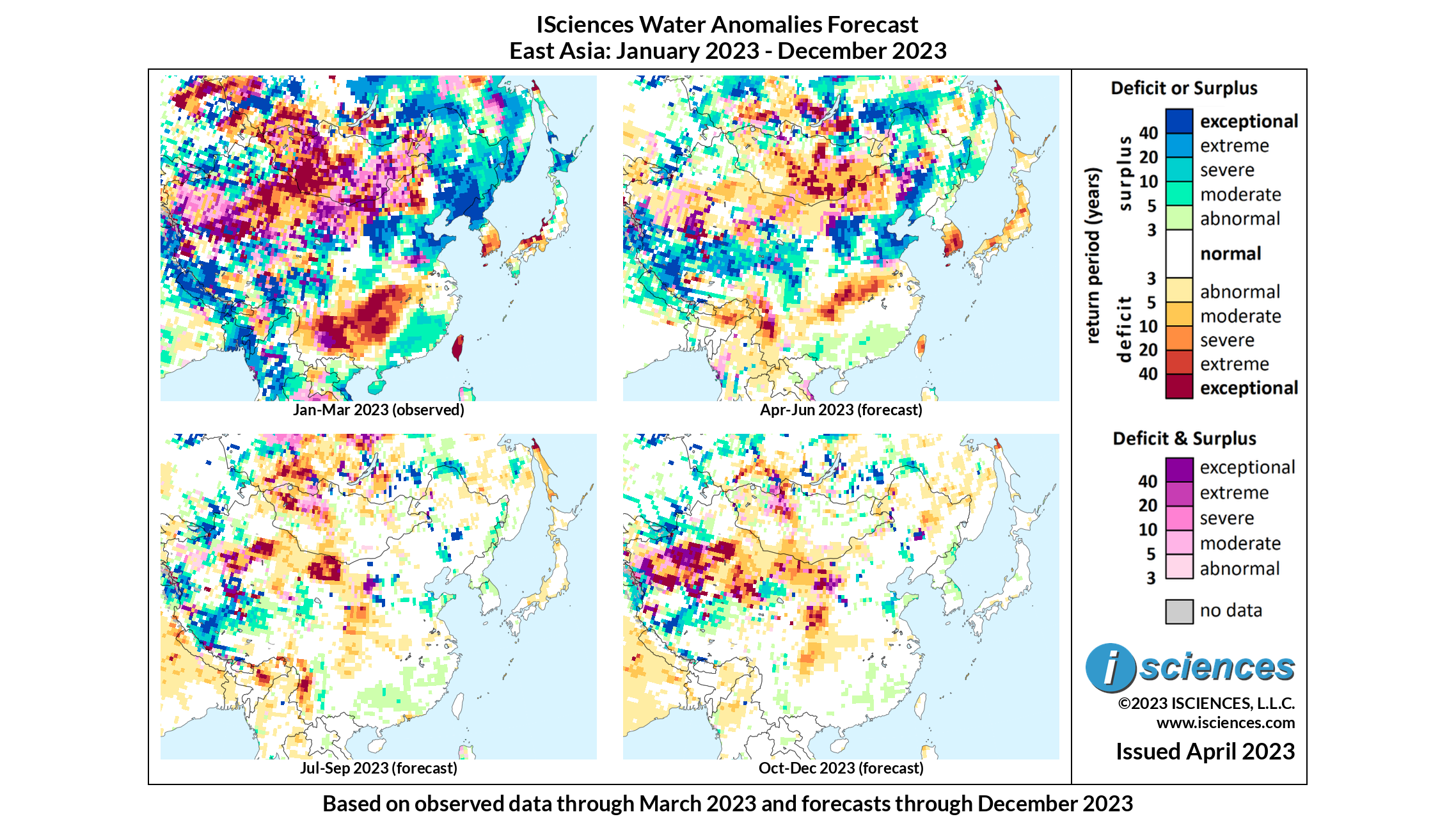East Asia: Intense deficits in N, NW China
27 April 2023
THE BIG PICTURE
The 12-month forecast ending in December 2023 indicates pockets of exceptional anomalies throughout East Asia, ranging from intense deficits in its northern and western regions, and surplus in its southwestern and northeastern regions.
Extreme to exceptional deficits can be anticipated in:
Northern and northwest China, throughout central to western Inner Mongolia and southeastern Xinjiang.
Northwestern Mongolia, near the Altai Tavan Bogd National Park. Severe transitional conditions are anticipated throughout the same region.
The Yangtze River Basin, through the Yunnan, Guizhou, and Sichuan regions.
Taiwan, throughout much of the country.
Severe to exceptional surpluses are expected in:
Northeast China, with the most intense anomalies appearing in the provinces of Shaanxi and Hebei.
Southwestern China, spanning across the southern border of Tibet. Areas in western regions of the Kashgar Prefecture, along its shared borders between Kazakhstan and Kyrgyzstan, can experience similar surpluses.
The 3-month maps (below) show the evolving conditions in more detail.
FORECAST BREAKDOWN
The forecast through June anticipates intense surpluses in northeast China, the Shandong Peninsula, western Tibet, and southwestern Tibetan Plateau. Intense deficits can be expected to persist along the Yangtze River Basin, as well as South Korea and Japan. Transitional conditions are expected in small pockets within western China, north of Tibet. Deficits are expected to persist in Taiwan, as well as South Korea and southern Japan.
From July to September 2023, most anomalies throughout China are expected to subside, though exceptional deficits can be expected to persist in central and western Inner Mongolia. Further southwest, exceptional surpluses are expected to occur throughout Tibet, as well as western to southwestern regions of Xinjiang.
The forecast for the final months – October through December 2023 – predicts most intense anomalies to disappear, with exceptional deficits and transitional conditions persisting in western Sichuan. Exceptional surpluses are expected to continue throughout Tibet and southwest of central Inner Mongolia.
Please note that WSIM forecast skill declines with longer lead times.
IMPACTS
13 of Mongolia’s 21 provinces are currently experiencing a dzud, a phenomenon unique to Mongolia during which heavy snow and extreme cold follows a summer drought, resulting in livestock deaths due to starvation and freezing. Occurrences of dzuds have increased in recent years, with occurrences now happening annually. This year, winter temperatures dropped as low as -40° Celsius, causing many malnourished animals to die, which affected the livelihoods of nearly 200,000 herding households already jeopardized due to inflation. As a result of the dzud, around 213,000 people, including 80,000 children, are now in need of humanitarian aid, including access to food and health services.
As Taiwan faces major drought, its government has implemented limits on residential water use, with some areas being cut off for two days a week. This drought has depleted reservoirs, cut off farmers from water sources, and limited production in some of the world's most advanced semiconductor factories. This is the third consecutive year the Taiwanese rice farmers have not been allowed to plant rice crops.
A study led by Chinese scientists found there has been a global transition from slowly developing droughts to flash droughts that develop rapidly and can become severe in a matter of weeks. Flash droughts, categorized as rapid onset and loss of moisture in plants and soil, are occuring increasingly more often on a global scale, which is leading to warmer temperatures and changing precipitation patterns. Last summer, China was hit by its most severe drought and heatwave in six decades, affecting electricity supply, food and factory production.
NOTE ON ADMINISTRATIVE BOUNDARIES
There are numerous regions around the world where country borders are contested. ISciences depicts country boundaries on these maps solely to provide some geographic context. The boundaries are nominal, not legal, descriptions of each entity. The use of these boundaries does not imply any judgement on the legal status of any territory, or any endorsement or acceptance of disputed boundaries on the part of ISciences or our data providers.
Subscribe to our monthly Water Watch List
Search blog categories
- *Precip/Temp Outlooks 101
- *Press Releases 1
- *Special Topics 16
- *Water Watch Lists 108
- Africa 117
- Australia & New Zealand 102
- Canada 103
- Central Asia & Russia 101
- East Asia 101
- Europe 108
- Mexico & C. Amer. & Carib 106
- Middle East 110
- South America 115
- South Asia 106
- Southeast Asia & Pacific 110
- United States 107
Search blog tags



